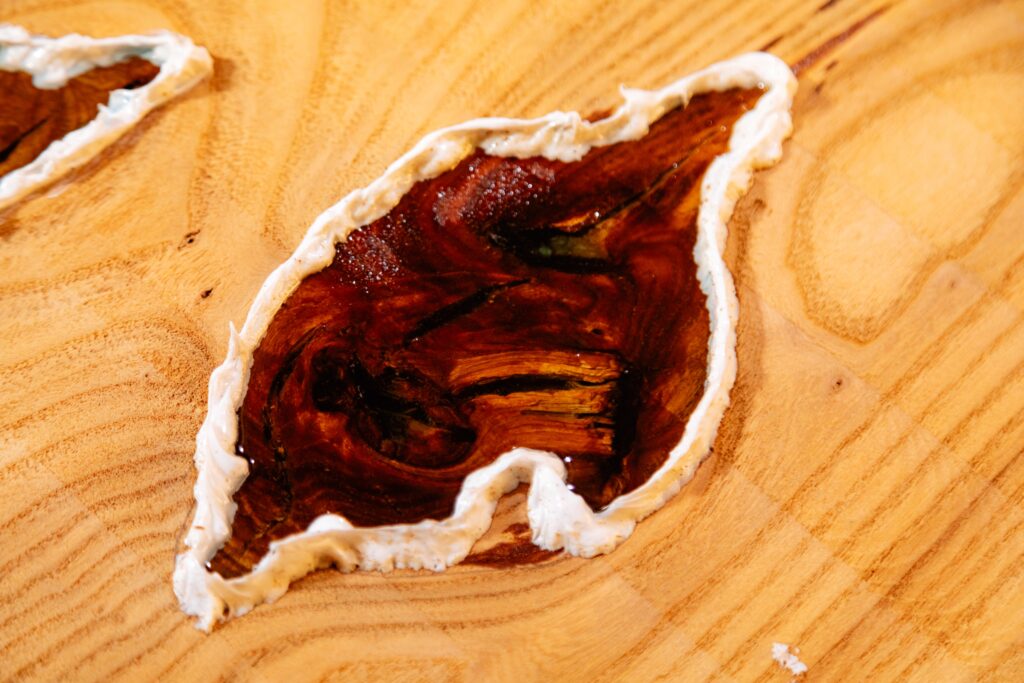Have you ever wondered if it’s possible to add color to resin using acrylic paint? Well, the good news is that you absolutely can! Resin is a versatile material that can be transformed into stunning artwork, and adding acrylic paint can take your creations to a whole new level. Whether you’re a seasoned resin artist or just starting out, this article will explore the process of coloring resin with acrylic paint and provide you with tips and tricks to achieve beautiful results. So let’s dive in and discover the wonderful world of combining resin and acrylic paint!

Introduction
When it comes to adding vibrant colors to resin projects, acrylic paint is a popular choice. Not only does it offer a wide range of colors to choose from, but it is also relatively easy to work with. Whether you are a seasoned resin artist or just starting out, coloring resin with acrylic paint can elevate your projects to a whole new level. In this comprehensive guide, we will walk you through the step-by-step process of coloring resin with acrylic paint, from preparing the resin to curing the final piece. So, grab your favorite acrylic paints and let’s get started!
Preparing the Resin
Clean the Surfaces
Before you start working with resin, it is crucial to ensure that the surfaces you will be using are clean. This includes the mold, mixing containers, and any tools you will be using. Resin is highly sensitive to dust, dirt, and other contaminants, which can affect the quality of the final result. Simply wipe down the surfaces with a clean cloth or use a mild soap and water solution to ensure a pristine working environment.
Mix the Resin
Once your surfaces are clean, it’s time to mix the resin. Follow the instructions provided by the resin manufacturer to achieve the desired resin-to-hardener ratio. This ratio is vital for proper curing and ensures the resin’s structural integrity. Use a separate mixing container and stir the resin and hardener together gently. Be sure to mix thoroughly until the solution is clear and free of any streaks.
Choose the Right Resin
Not all resins are created equal, and choosing the right resin is essential for successful coloring with acrylic paint. Look for a resin that is compatible with acrylic paints and provides good adhesion. Epoxy resins are commonly used for resin art and have excellent color retention properties. It is important to check the resin manufacturer’s instructions regarding compatibility with acrylic paints before proceeding.
Selecting the Acrylic Paint
Opt for High-Quality Acrylic Paints
When choosing acrylic paint for coloring resin, opt for high-quality paints. These paints are usually made with a higher concentration of pigments, resulting in more vibrant colors. They also tend to have a smoother consistency, making them easier to mix with the resin. Investing in good quality acrylic paints will ensure that your resin projects have a professional and visually appealing finish.
Consider the Pigmentation
The pigmentation of the acrylic paint plays a significant role in the final result. Some acrylic paints have a higher pigmentation, resulting in more opaque colors, while others may be more translucent. Consider the desired effect you want to achieve and choose acrylic paints accordingly. Keep in mind that more opaque colors will require less paint for achieving the desired intensity.
Testing the Compatibility
Perform a Small Test
Before diving into your main resin project, it is always a good idea to perform a small test to ensure compatibility between the acrylic paint and the resin. Mix a small amount of resin and hardener according to the manufacturer’s instructions, and add a small drop of acrylic paint. Mix thoroughly and observe any changes in texture or color. This step will help you determine if there are any unwanted reactions between the paint and the resin.
Check for Unwanted Reactions
During the test, keep an eye out for any unwanted reactions, such as clumping, excessive bubbling, or inconsistent curing. These reactions may indicate that the selected acrylic paint is not compatible with the resin you are using. If you notice any undesirable effects, consider trying a different brand or type of acrylic paint. It is always better to identify compatibility issues during the testing phase rather than ruining your main project.

Mixing the Acrylic Paint with Resin
Start with Small Amounts
When it comes to mixing acrylic paint with resin, it is best to start with small amounts. This allows you to have better control over the color intensity and ensure that the paint is fully incorporated into the resin. Remember, it is easier to add more paint to darken the color than it is to lighten it once it has been mixed. Gradually add small amounts of acrylic paint to your resin mixture and observe the color transformation.
Mix Thoroughly
To achieve a uniform color, it is important to mix the acrylic paint thoroughly into the resin. Use a stir stick or a craft stick to gently stir the paint and resin mixture. Make sure to scrape the sides and bottom of the container to ensure that all the paint is fully incorporated. Keep mixing until you achieve a consistent color without any visible streaks or clumps of paint.
Ensure Proper Consistency
Apart from achieving the desired color, it is also important to ensure the proper consistency of the mixed acrylic paint and resin. The consistency should be smooth and fluid, similar to that of honey. If the mixture is too thick or has a gloopy texture, add a small amount of resin to thin it out. On the other hand, if the mixture is too runny, add a tiny amount of acrylic paint to thicken it slightly. The ideal consistency allows for easy pouring and coating of the mold surface.
Adding the Acrylic Resin to Mold
Coating the Mold Surface
Before adding the colored resin mixture, it is essential to coat the mold surface with a clear resin layer. This step helps to prevent any air bubbles from forming between the mold and the colored resin. Use a brush or a wooden stick to spread a thin, even layer of clear resin on all the surfaces of the mold. Take care to cover any intricate details or crevices in the mold. This clear resin layer acts as a barrier, ensuring a smooth and flawless end result.
Layering Technique
Once the mold surface is coated with clear resin, it’s time to add the colored resin mixture. pour the colored resin slowly and evenly into the mold, making sure to cover the entire surface. If you want to create layered effects or add different colors, allow each layer to partially cure before adding the next one. This layering technique allows you to create depth and dimension in your resin artwork.

Curing the Resin
Follow the Resin Manufacturer’s Instructions
Proper curing is crucial for the longevity and durability of your resin projects. Different resins have varying curing times and optimal curing conditions. It is important to follow the resin manufacturer’s instructions carefully to ensure a successful curing process. Factors such as temperature, humidity, and ventilation can affect the curing time and final outcome.
Allow Sufficient Curing Time
Resist the temptation to rush the curing process. Allow sufficient curing time for the resin to fully harden and cure. This usually ranges from 24 to 48 hours, but it can vary depending on the type of resin and other environmental conditions. Avoid touching or disturbing the resin during the curing process to prevent smudging or damaging the surface. Patience is key when it comes to resin art projects.
Post-Curing Efforts
Removing Any Imperfections
After your resin has cured, you may notice some imperfections such as air bubbles, surface scratches, or dust particles. Don’t worry, these can be easily fixed. use a fine-grit sandpaper or a sanding block to gently sand the surface of the resin, focusing on the areas with imperfections. This will help to smooth out any unevenness and eliminate unwanted blemishes. Follow up with a polishing compound or a resin-specific polish to restore the resin’s shine and clarity.
Applying a Protective Coating
To enhance the longevity and protection of your colored resin piece, consider applying a protective coating. This can be done using a clear resin or a resin-specific sealant. apply a thin, even layer over the cured resin, making sure to cover all surfaces. This additional layer acts as a barrier against UV rays, scratches, and general wear and tear. It also gives the resin a glossy and professional finish.

Advantages of Using Acrylic Paint to Color Resin
Wide Range of Colors
One of the major advantages of using acrylic paint to color resin is the wide range of colors available. Acrylic paints come in a plethora of shades, from vibrant primary colors to subtle pastels and metallics. This allows for endless possibilities in terms of color combinations and customization. Whether you prefer bold and vibrant hues or soft and muted tones, acrylic paints have got you covered.
Ease of Use
Another advantage of using acrylic paint is its ease of use. Acrylic paints are water-based, which means they can be easily mixed with water or other mediums to achieve the desired consistency. They also dry relatively quickly, making them ideal for resin art projects where time is of the essence. Additionally, acrylic paints are readily available in art supply stores and online, making it convenient to source and experiment with different colors.
Cost-Effectiveness
Compared to other coloring options, such as resin dyes or pigments, acrylic paint is a cost-effective choice. Acrylic paints are generally more affordable and offer a better value for money, considering the wide range of colors and versatility they provide. A small tube of acrylic paint can go a long way, making it a budget-friendly option for resin artists of all levels.
Conclusion
Coloring resin with acrylic paint opens up a world of possibilities for resin artists. From vibrant and bold designs to soft and ethereal creations, acrylic paints offer versatility and ease of use. By following the step-by-step process outlined in this guide, you can confidently add beautiful colors to your resin projects. Remember to choose the right resin, select high-quality acrylic paints, and test compatibility before proceeding. With a little practice and experimentation, you can create stunning resin artworks that reflect your unique style and creativity. So, grab those brushes and let your imagination run wild!




